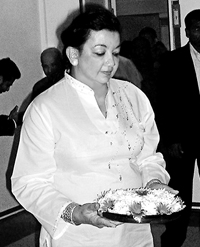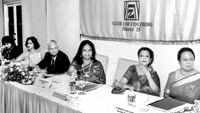|
|
|||||||||
|
First Lady at London Vihara First Lady Shiranthi Rajapaksa, visited the oldest Sri Lankan Buddhist temple in the west, during her brief stay in the UK. On her arrival at the London Buddhist Vihara, the First Lady was given a warm welcome by the Deputy Head of the Vihara, Ven. B. Seelawimala, along with the resident monks.
She was accompanied to the Vihara by Sri Lanka’s Deputy High Commissioner in London Sudantha Ganegama Arachchi. Following the offering of flowers by Mrs. Rajapaksa, the resident monks of the Vihara chanted Seth Pirith to invoke blessings upon her. During his welcome speech, Ven. Seelawimala asked Mrs. Rajapaksa to convey a message of best wishes and blessings of the Triple Gem to Sri Lanka’s President for his endeavour to achieve peace and prosperity in Sri Lanka. Mrs. Rajapkss was in London to represent the President
at ‘Refreshingly Sri Lanka’ – the ongoing trade
and tourism festival organised by the Foreign Ministry. AGM of Zonta Club I of Colombo The Annual General Meeting of Zonta Club I of Colombo was held on May 24 at the Akasa Kade Club, Ceylinco Seylan Towers. Zonta International is a worldwide service organisation of executives in business and professions, working together to advance the status of women.
District Governor of District 25 Dilruba Ahmed
from Bangladesh was present at this meeting. She inducted the incoming
President Sumithra Fernando and the New Board members for the biennium
2006 – 2008 in a colourful ceremony. Secretary Renuka de Silva, read a message sent by Zonta International President Mary Ellen Bittner. “I thank the outgoing President for her services rendered. I congratulate the incoming President. Through your involvement in Zonta, you are doing so much to make the world a better place for women, and as you have heard me say before, we all know that a better world for women is a better world.”. Why Vessagiriya? Why forgotten and abandoned Vessagiriya for exploration and excavation, we ask the Director of the Project, Prof. Sudharshan Seneviratne.
Vessagiriya was the southern most point of ancient Anuradhapura and we have been looking at it as a trajectory. It is a heavily endangered site due to pollution and desecration. The pilgrims who come to Anuradhapura use the caves of Vessagiriya as their toilets, says this Professor of Archaeology who wears many hats as Senior Advisor on Culture to the Foreign Ministry, Director of the Jethavana Project and Co-Director of the Anuradhapura Citadel Project. After Poson, pilgrims’ and other visitors’ indifference not only to the environment but even to places of historical and religious importance is evident, with polythene strewn all over Vessagiriya. Another pointer to their blatant disregard is the fresh graffiti on the rocks right under the ancient Brahmi inscriptions. It is only on and off that the searchlight has fallen on Vessagiriya though it has early inscriptions dating back to the 3rd century BC, drip-ledge caves, architectural monuments, traces of ancient paintings similar to the frescoes of the Sigiriya-Polonnaruwa periods and sculpture, ancient structures for hygiene such as toilet facilities and natural habitat in the form of rocks and trees, according to Prof. Seneviratne. In the early 20th century, British archaeologist H.C.P. Bell prepared a plan of Vessagiriya and marked the three rock outcrops A-B-C, mapped the site and did preliminary excavations. In 1970, Prof. Senarat Paranavitane and H. W. Nicholas studied the inscriptions and published their findings. “But most of the time Vessagiriya has been in limbo and neglected,” says Prof. Seneviratne, explaining that in 1999, the Department of Archaeology, University of Peradeniya undertook a preliminary survey and requested permission to launch a scientific investigation. 2001 saw a renewal of the project with the support of the government Department of Archaeology and in 2005 the Central Cultural Fund (CCF) called for a six-year plan. In the ongoing project, stressing the importance of looking at the periphery of what once was the citadel of Anuradhapura, we put forward a proposal looking at the whole southern sector, south of the Sri Maha Bodhi., covering the Dakkhina stupa (Elara’s tomb), Ranmasu Uyana, Isurumuniya and Vessagiriya. “The main objective is to develop the sites for cultural tourism, while taking urgent steps to research, revitalize, conserve and protect them,” he says passionately discussing the need to go beyond the citadel of Anuradhapura where royalty lived to check out how the common men, women and children went about their routine centuries ago. “This is the bigger history.” The preliminary programme includes a field survey and probe excavations. While the research agenda has many segments covering research and training (Prof. Seneviratne says there is a richness in Vessagiriya from a training point of view as it is a “composite” site), those involved in this project are the CCF (Jetavana project archaeology team), Archaeological Department of Sri Lanka, the Peradeniya University’s Dept. of Archaeology and several members of the Science and Agriculture Faculties of the university. Referring to the undergraduates, facing the rigours here away from the comfort of their hostel or homes and unwilling to leave even to get some administrative matters sorted out at Peradeniya, Prof. Seneviratne says he is very proud of their professionalism, dedication and determination. “We are training the next generation of professionals under very tough conditions.” The futuristic plan is to include Vessagiriya as part of a tourist stop by making the entry from the southern point of Anuradhapura and then going on to the other places of historical importance in a northwardly direction in the Heritage City. |
|||||||||
Copyright © 2006 Wijeya Newspapers
Ltd. All rights reserved. |


